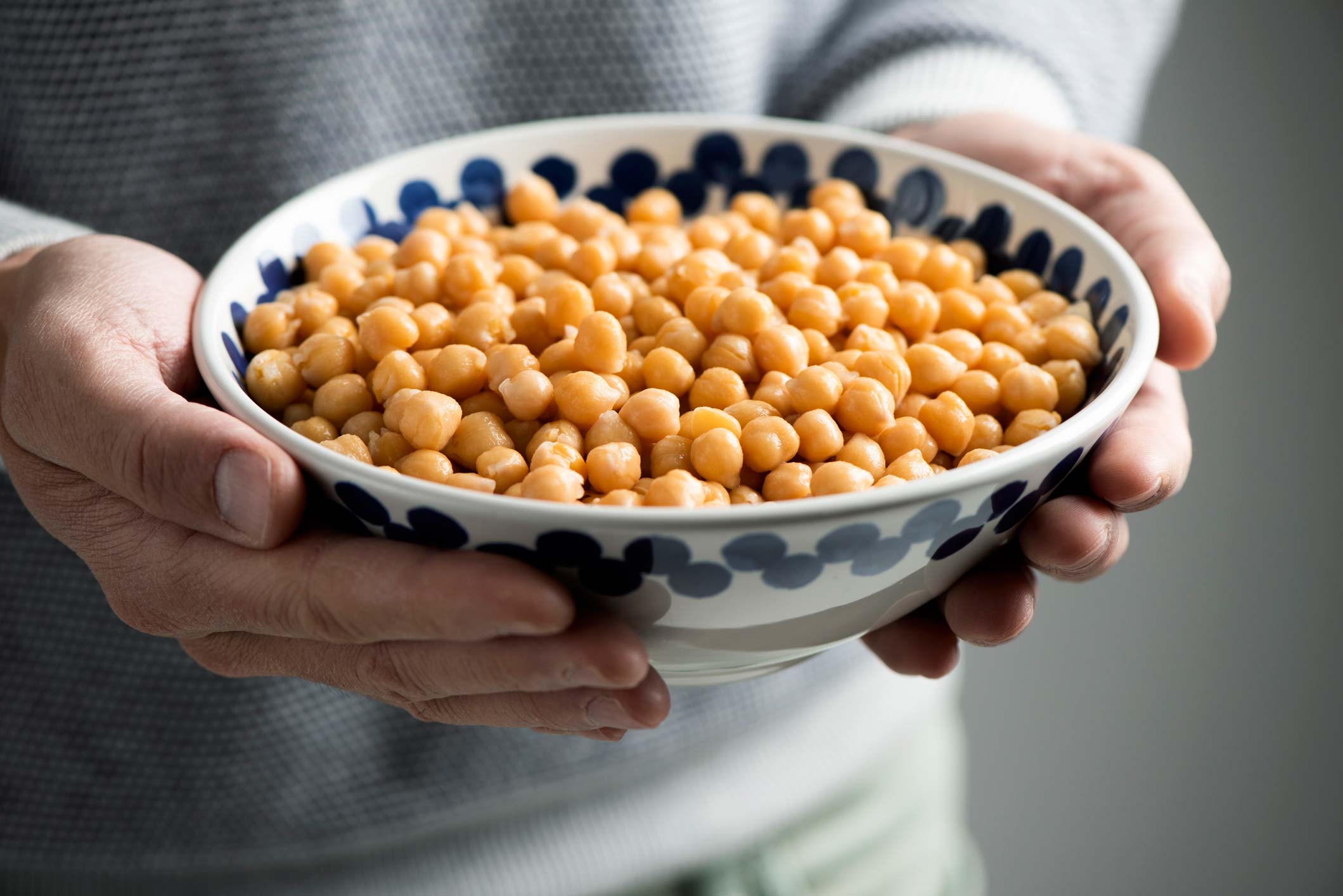Yes, they sound like a clown name, but don’t pity them. Garbanzos were named a top food trend for 2021 by Whole Foods, suggesting that these little beans are going to steal the spotlight as a consumer food favorite this year. While we don’t know the rationale for this prediction (it’s a little like the Oscars, but with considerably less controversy and a much shorter ceremony), it’s reasonable to guess that the humble garbanzo is this year’s “It Bean” thanks to its incredible versatility. These days we’re going far beyond hummus, having garbanzos as crunchy roasted snacks, in gluten-free pasta, and mashed in “chickpea salad” sandwiches.
Garbanzos have been called “a prince among pulses” and even “the new cauliflower,” indicating that they’ve gone from back-of-the-pantry to kitchen staple status. And not surprisingly, since their relatively neutral taste makes them a versatile base for many products and recipes. Indeed, there’s more to garbanzos today than hummus. So what are their benefits, are there any downsides to eating them, and what are some creative ways to use them?
What Are Garbanzos?

Garbanzos originated in the Middle East, likely in what are now the regions of southeastern Turkey or northern Syria. They’re the world’s second most widely grown legume after the soybean, and one of the eight founder crops (plants that archeologists consider the foundation of agriculture on our planet).
Garbanzos are also called chickpeas. The two names are used interchangeably in many English-speaking countries. And in this article, I’ll use both because I think they’re both pretty fun to say.
Garbanzos fit into the legume category, along with peas, lentils, and other beans. In Africa and parts of the Middle East, garbanzos are also known as Egyptian peas. And although the common garbanzo bean at stores is generally tan or beige, there are also yellow, red, dark green, and brown chickpea varieties.
Garbanzos Nutrition
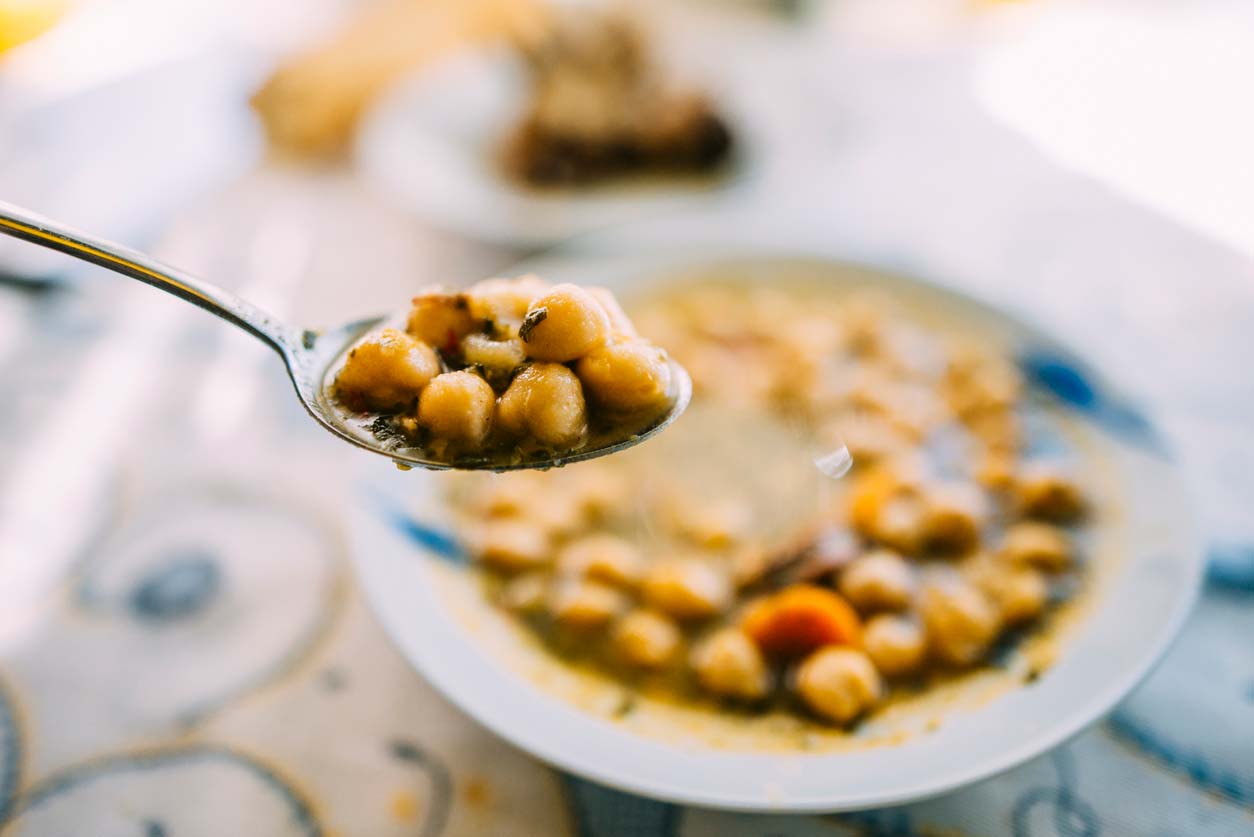
Garbanzos and other legumes are some of the most nutritious foods on the planet. They’re a healthy source of fiber, plant-based protein, and a number of vitamins and minerals.
In a 1/2-cup serving of cooked garbanzo beans, you’ll find the following basic nutritional profile:
- Calories: 135
- Protein: 7 grams
- Fat: 2 grams
- Total Carbohydrates: 22 grams
- Fiber: 6 grams
Even in this small portion size of garbanzos, you’ll get a nice serving of magnesium, manganese, iron, phosphorus, copper, folate, and zinc. It also provides some calcium and B vitamins.
Benefits of Garbanzos
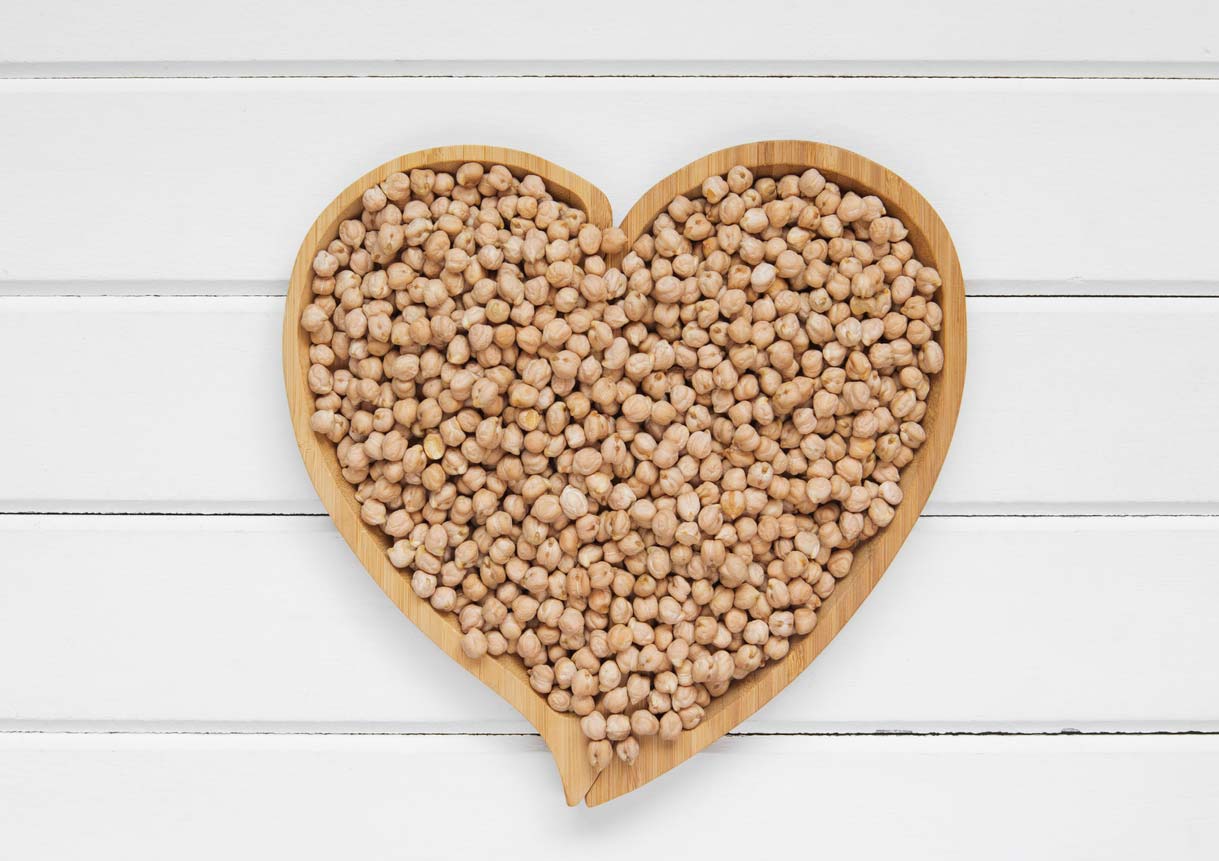
Garbanzos have proven themselves as a great source of nutrients, but what else makes them so deserving of a spot in the front of your cupboard? Research has shown that including garbanzos — and hummus — as a regular part of your diet is associated with a number of health benefits, including a lower risk for various diseases and improved overall nutritional status.
Anticancer Benefits
Beans is the first “B” in the acronym G-BOMBS (the second B is for berries, which are also great, but not the star of this article), coined by my friend and colleague Dr. Joel Fuhrman. G-BOMBS (Greens, Beans, Onions, Mushrooms, Berries, Seeds) describes some of the best anticancer and health-promoting foods on the planet that you should consider incorporating into your diet on a daily basis.
Beans and legumes are full of nutrient-dense carbohydrates that digest slowly to help stabilize blood sugar. They contain high levels of fiber and resistant starch, which are fermented by bacteria in your intestines, creating cancer-preventing fatty acids. In fact, eating legumes like garbanzos at least twice per week may cut your risk for colon cancer in half!

Cardiovascular Benefits
Authors of a 2015 study published in the journal Clinical Diabetes found that in addition to being a highly nutritious food, legumes like garbanzos can help prevent and manage a number of other health conditions. For instance, a high intake of legumes is associated with a lower risk for high blood pressure, heart disease, stroke, and type 2 diabetes. And eating them may help lower blood fats, like LDL “bad” cholesterol, which are known to raise your risk of developing heart disease.
Metabolic Benefits
Eating garbanzos may also make you less likely to develop metabolic syndrome. This describes a group of conditions associated with type 2 diabetes and heart disease. According to a 2020 study published in Applied Sciences, which examined data from the National Health and Nutrition Examination Survey (2005–2016), adults who ate chickpeas and hummus regularly were 48% and 62% less likely to have metabolic syndrome, respectively.
When combined with high glycemic foods, garbanzos can help reduce the overall glycemic load of the whole meal of which they’re a part. This means that they can help slow the rise in blood sugar and insulin response. One study found that adding garbanzos to white rice at a meal significantly reduced glycemic response compared to eating white rice alone.
Weight Management Benefits
Eating pulses (that is, the edible seeds of legume plants, and not the rhythmic beating in your wrist and neck), either by themselves or as a regular part of your diet, has also been found to help keep you feeling fuller and prevent overeating that could lead to unwanted weight gain. They’re also associated with lower body weight overall, smaller waist circumference, and lowered risk of obesity in epidemiologic studies.
Digestive Benefits
Furthermore, eating garbanzos contributes to improved digestive health. Legume consumption is associated with better bowel regularity and lower incidence of constipation. Plus, chickpeas may help reduce inflammation in the GI tract. One 2018 animal study found that supplementing mice with 20% cooked chickpea flour for three weeks before being induced with an inflammatory colon condition actually helped reduce inflammatory biomarkers, compared to mice not given the chickpea supplement. (Of course, it would be nice if humans could just give the mice chickpeas, without having to give them a disease, too.)
Downsides to Garbanzo Beans

Along with their many health benefits, garbanzos also come with a few things to be aware of, including possible digestive discomfort (at first), a legume-related allergy for some people, and easily dealt with nutrient and sourcing concerns.
Some people may take time to adjust to the chickpeas’ fiber content — similar to any other bean. If you’re not used to eating a lot of fiber-rich foods in your diet — like raw fruits and vegetables, whole grains, nuts, seeds, and other legumes — garbanzos may cause digestive symptoms like increased gas, abdominal cramps, or bloating. However, a 2011 study suggests that consumer perception of the link between eating beans and unwanted gas may be exaggerated. (Sadly, the published study, soberly titled “Perceptions of flatulence from bean consumption among adults in 3 feeding studies,” did not reference the ditty that starts with “Beans, beans, the musical fruit.”)
To minimize these effects, start with a small number of garbanzos and increase your intake of them slowly. Be sure to drink plenty of water for a smoother move through your digestive system.
What About Phytates?
Beans like garbanzos contain substances called phytates, which have been subject to some nutritional controversy. Like other substances found in plant foods, such as lectins and tannins, phytates have been dubbed “anti-nutrients” because they can bind to and inhibit the absorption of certain micronutrients when eaten around the same time.
How does this work? Phytic acid binds to certain essential minerals, including iron, calcium, zinc, and magnesium, which can make those minerals less bioavailable when consumed. This sounds like a bummer, but it’s been made out to be more alarming than it actually is for most people. Phytates seem to be most problematic when consumed in raw form. But last I checked, most of us aren’t sitting down to eat a bowl full of uncooked garbanzos or other legumes. (If you are, I want to meet your dentist!)
You can easily reduce the phytate content of legumes in your meal prep. Sprouting, cooking, soaking, and fermenting all help to destroy phytates and allow for increased mineral availability. (This is also true for lectins, which are really not a point of concern either so long as you cook your garbanzos properly.) If you choose to cook chickpeas from their dry form, soaking them will reduce phytates and increase the bioavailability of some of their nutrients. It’s ideal to soak beans for 24-48 hours, rinsing twice per day, before cooking.
Since garbanzos are not eaten raw (unless sprouted, and even then, we’d recommend cooking them), most of the phytates are destroyed before they hit your plate, so it’s not much of a concern. Eating a balanced, whole foods, plant-based diet, including plenty of vitamin C (which tends to support nutrient absorption) with your garbanzos, can help make sure you’re absorbing the vitamins and minerals you need.
Chickpea Allergy
While not heard about as often as peanuts or dairy allergies, chickpea allergies can occur. This is more likely if there is already an allergy to other legumes, especially lentils and peas. The most frequent reaction is hives or other skin reactions. If you suspect or are diagnosed with a chickpea allergy, it’s likely best to avoid them.
Glyphosate
Glyphosate, manufactured by Bayer under the brand name RoundUp, is a likely cancer-causing herbicide sprayed on crops such as wheat, garbanzos, and other legumes as a desiccant to speed up the harvesting process. Because of this, some caution is necessary when eating large amounts of conventionally grown garbanzo beans and products made with them, including hummus and garbanzo pastas.
While organic farms do not use RoundUp, unfortunately, choosing organic isn’t a guarantee of zero RoundUp exposure in this case. The Environmental Working Group (EWG) conducted testing on non-organic hummus and chickpea products and found the presence of glyphosate in 90% of them. They also tested 12 organic hummus and chickpea products and still found traces of glyphosate, though at much lower amounts than the conventionally-grown products.
Why is RoundUp still found in organic products even though its usage isn’t allowed in their production? Most likely, they were cross-contaminated by nearby crops sprayed with the herbicide.
Even though the EWG test results aren’t what we want to hear, the organization still says that people shouldn’t stop eating hummus and other chickpea products because of it. These foods are important sources of protein, fiber, and other nutrients in a healthy diet. Furthermore, the EWG says that even though small levels of glyphosate were detected in some organic products, choosing organic hummus is still better than not eating hummus or chickpeas at all.
What should you do to avoid glyphosate? Try to choose chickpeas and hummus that are lower in glyphosate or have non-detectable amounts according to the EWG test results table. And despite the presence of some glyphosate residues in organically grown chickpeas, they are likely to be lower in it. So go organic if you can.
Are Chickpeas a Sustainable Crop?

One of the biggest questions that many consumers have about popular food trends is whether they’re sustainable. I’m happy to report that, when it comes to garbanzo beans, the answer is a solid yes.
Garbanzo crops can help restore soil, and, if they’re well managed, can even sequester carbon from the atmosphere. Like all legumes, garbanzo crops also leave extra nitrogen in the soil they’re grown in for future crops to use, which can be especially helpful for growers who rotate crops.
Researchers from Trinity College Dublin have also said that chickpea pasta is a more sustainable alternative to pastas and grain products made from wheat. And they’re healthier for the consumer: The chickpea alternative was found to contain one and a half times more protein and over three times more fiber than durum wheat pasta.
Garbanzos and Garbanzo Products

Garbanzos in their whole bean form come dry or canned. Stored in a cool, dark place, dried chickpeas will keep for at least a year. Canned beans usually last for a couple years as well, making both options excellent pantry staples.
With the popularity of chickpeas, there has also been an increase in chickpea products. Naturally wheat-free chickpea pastas, like rotini and penne, have made a recent market splash. Roasted seasoned chickpeas, chickpea puffs, and chips are also becoming regulars in the snack aisle. And chickpea flour is a newcomer to the gluten-free section of the baking aisle. Of course, hummus and other dips that incorporate garbanzo beans continue to have high consumer demand.
How to Use Garbanzos

Garbanzos are super easy to incorporate into your diet and require very little special prep work. If you choose to buy them canned, all you have to do is drain and rinse them.
If you buy dried garbanzos, you’ll have to soak and cook them. To soak, cover dried garbanzos with water in a large pot and allow them to soak for 24-48 hours, rinsing twice per day. Then, you can either cook them by simmering in new water on the stove, in a crockpot, or by using a pressure cooker to reduce cooking time. When cooking, you might want to add a bay leaf or a little dried kombu (a sea vegetable) for a pleasant hint of extra flavor. Spices like fennel, cumin, caraway, ginger, and turmeric are great flavoring agents for garbanzos and make them more digestible, too.
To use garbanzos in your own culinary creations, try them in these ways:
- Dips like hummus
- Seasoned and dry roasted in the oven for a snack
- Indian dishes like chana masala, dals, or curries
- In soups and stews
- In veggie burgers and patties
- As a topping for dishes like baked sweet potatoes or salads
- Mashed and used in place of canned chicken or tuna in chickpea salad sandwiches
- Blended in a food processor with peanut butter, oats, and dates as a base for high protein snack balls (see the recipe for Oatmeal Chickpea No-Bake Cookie Dough below!)
Aquafaba
The liquid from cooking garbanzos, and the liquid that surrounds canned garbanzos, offers a unique opportunity to be both waste-minimizing and innovative. The liquid from cooked and canned garbanzos that most people generally discard is called aquafaba (Latin for “bean water”). You can use it in baked goods as a binder and a vegan alternative to eggs. You can even whip it into a meringue! Simply whip it with a bit of cream of tartar and watch a stiff foam form in a matter of minutes.
3 Creative Chickpea Recipes
The recipes below are just the tip of the iceberg when it comes to how chickpeas offer delicious and nutritious presence and diversity to the culinary world. We weren’t sure whether to start or end with the Oatmeal Chickpea No-Bake Cookie Dough since this recipe could easily become a sustainable breakfast or a healthy treat with its high fiber and protein content. We’ll let you choose, so let us know which way you love it most.
If you’re a crunchy snacker, Moroccan Baked Chickpeas will soon be your BFF with their worldly flavor. And finally, move over black beans; it’s time to experiment with another bean for a super flavorful, samosa-style chickpea and potato burger that’s as tasty as it is easy to make!
1. Oatmeal Chickpea No-Bake Cookie Dough

This recipe is sure to confirm your notion that chickpeas are pretty magical. In this Oatmeal Chickpea No-Bake Cookie Dough, high-protein and high-fiber chickpeas create the most delicious cookie dough that you can enjoy straight out of the jar or baked into a soft and chewy treat. With seven grams of plant-based protein and over five grams of fiber per serving, plus flavor to boot, you can’t go wrong with this tasty and nutritious snack!
2. Moroccan Baked Chickpeas
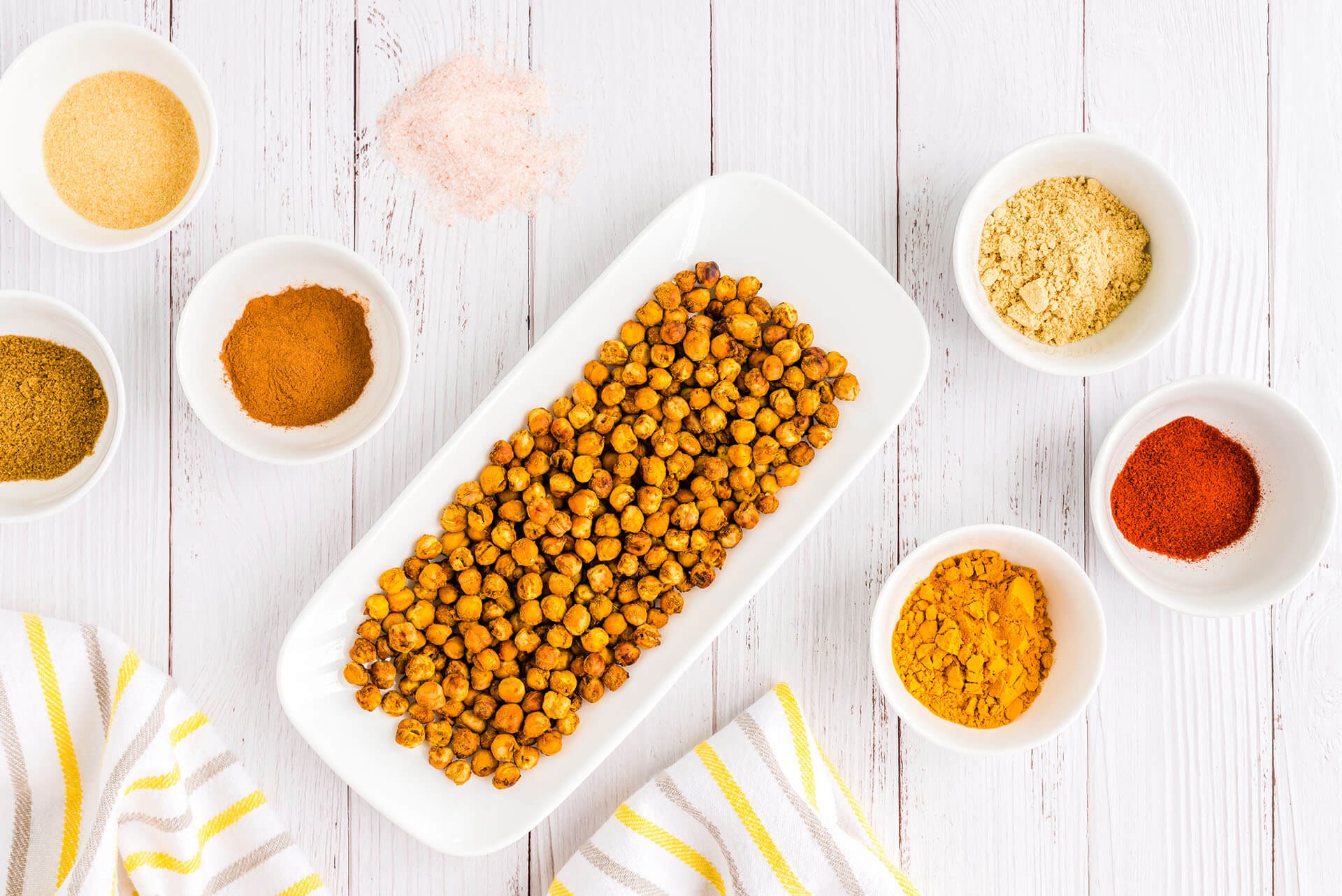
Do you consider yourself a crunchy snacker? Looking for an ideal nibble to replace those chips that aren’t serving your health so well? Chickpeas get perfectly crunchy in the oven (with a little tossing in between). All you have to do is add your favorite seasonings. This flavorful, Moroccan-style baked chickpea snack will get you started with a healthier, high-fiber and protein-rich alternative to those traditionally fried and salty chips.
3. Chickpea and Potato Samosa Burgers
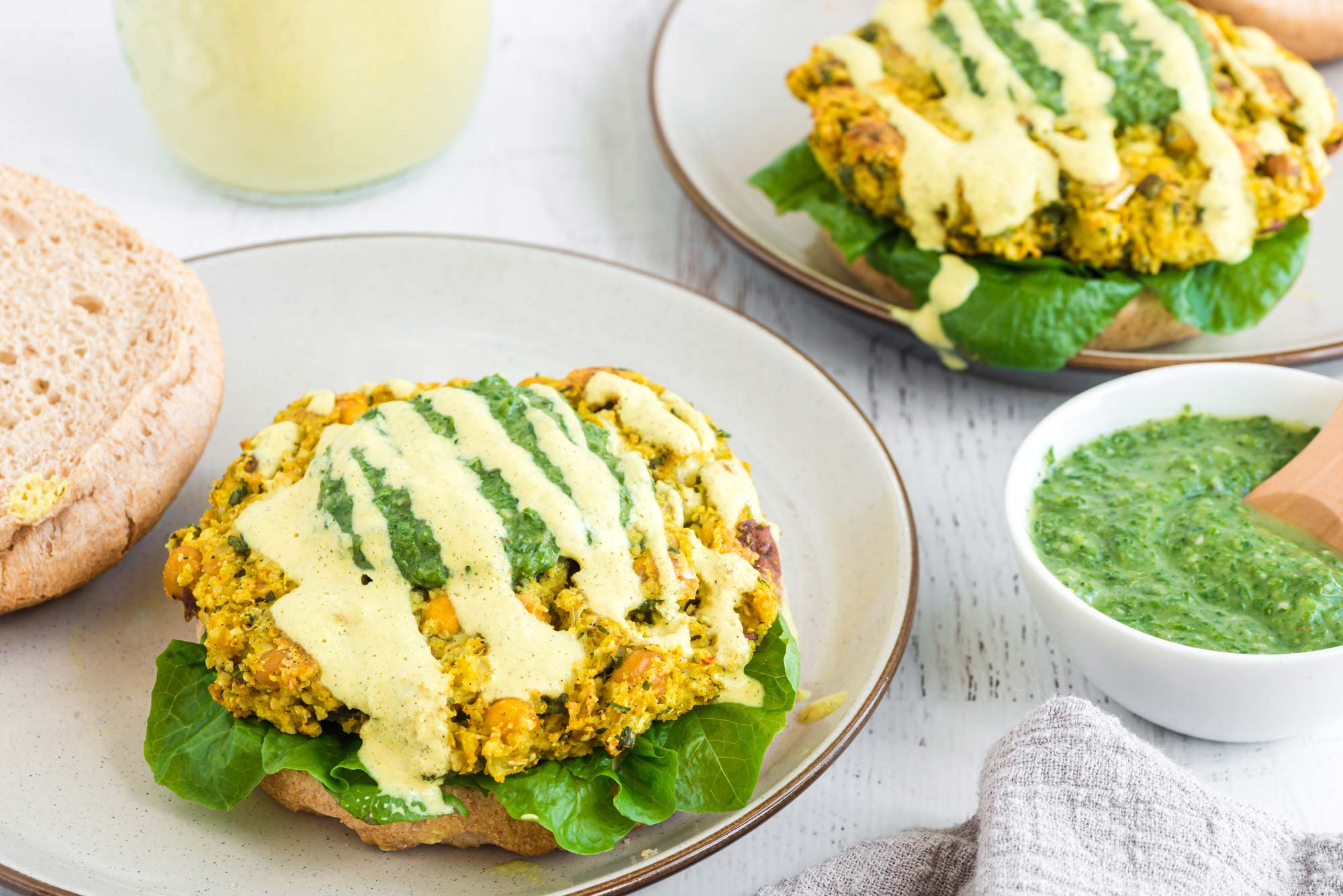
Chickpeas make fabulous burgers, and if you love Indian spice as much as we do, then trust us, these burgers might make it to your recipe library of fame. Serve them with mint chutney and plant-based yogurt, as well as plenty of veggies on top like pickled onions, leafy greens, or sliced tomato for the ultimate chickpea burger experience.
Garbanzos Deserve a Spotlight in Your Kitchen

Garbanzos are becoming an increasingly popular plant food, and for good reason. Like other legumes, they’re highly nutritious and a good plant-based alternative to meat. As well as offering a number of important health benefits, they’re also a sustainable crop, and have a wide variety of uses in cooking and baking. While there are a few potential downsides to consuming chickpeas, including exposure to glyphosate in some products, they can make an important contribution to a varied and whole-food-based diet.
Tell us in the comments:
- What are your favorite ways to eat garbanzos? What new ways are you considering trying them in your diet?
- Have you ever used aquafaba in baking? What did you think?
- Have you noticed an increased presence of chickpea products in your local markets?
Feature image: iStock.com/nito100
